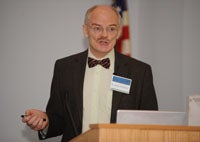Exploring Both Sides of the Cancer Coin

Posted in GUMC Stories
 Anton Wellstein, M.D., Ph.D., knows that biology doesn’t care about the silos that have traditionally been built between medical disciplines. That’s why Wellstein, a professor of oncology and pharmacology, has long collaborated with researchers and physicians in other fields and specialties to explore the yin and yang of cancer.
Anton Wellstein, M.D., Ph.D., knows that biology doesn’t care about the silos that have traditionally been built between medical disciplines. That’s why Wellstein, a professor of oncology and pharmacology, has long collaborated with researchers and physicians in other fields and specialties to explore the yin and yang of cancer.
“What can be bad for us in cancer may be good for us in other diseases, and vice versa,” says Wellstein, who is also associate director for basic science at Georgetown Lombardi Comprehensive Cancer Center.
To explore what he calls “both sides of the cancer coin,” Wellstein has forged alliances with cardiologists, rheumatologists, nephrologists, and others at Georgetown over the 23 years he has been here.
One seemingly unlikely connection may soon pay off for patients.
To help the treatment of chronic wounds (those that never heal or take years to do so), Wellstein hopes to borrow a trick from cancer—a disease that often co-opts a healthy biological process to survive.
In a recent study, Wellstein showed that a powerful molecule, known as fibroblast growth factor binding protein-1 (FGF-BP1), enhances the healing of skin wounds and repair of injured tissue in animals. Ironically, this is the same protein that tumors use to keep growing.
Cancer has often been called a non-healing wound, Wellstein says, and he has worked for decades to understand the molecular reasons for this observation.
As far back as the 1850s, doctors have noted that cancer, which can be described as open sores inside the body, and flesh wounds resemble each other. Both often involve inflammation, followed by growth of new cells and tissue. Yet while this regeneration process stops in wounds once healing is complete, it continues unabated in cancer.
The Dark Side of Inflammation
 The role of inflammation in wound healing was once thought to be limited to preventing infection. But Wellstein has found that similar processes are also used to signal the construction of new blood vessels in order to help repair the vessels that might have been damaged in an injury. In a seminal study published 1997 in Nature Medicine, Wellstein and his colleagues found that cancer can co-opt this function. When cancer cells express the FGF-BP1 gene, they draw more blood vessels into developing tumors, nourishing them in a process known as angiogenesis. “This protein is a driver for angiogenesis and, in turn, recruitment of immune cells that can stimulate tumor growth,” he says. “This is the dark side of inflammation.
The role of inflammation in wound healing was once thought to be limited to preventing infection. But Wellstein has found that similar processes are also used to signal the construction of new blood vessels in order to help repair the vessels that might have been damaged in an injury. In a seminal study published 1997 in Nature Medicine, Wellstein and his colleagues found that cancer can co-opt this function. When cancer cells express the FGF-BP1 gene, they draw more blood vessels into developing tumors, nourishing them in a process known as angiogenesis. “This protein is a driver for angiogenesis and, in turn, recruitment of immune cells that can stimulate tumor growth,” he says. “This is the dark side of inflammation.
“But there is also the flip side,” he adds. “When we looked into wound healing, we found that FGF-BP1 is quickly upregulated—production is turned on—in a fresh wound.”
Wellstein and his 15-member lab then laboriously built a mouse model of wound healing in which they could control the function of FGF-BP1. When they turned on expression of the protein in mice, they could see that wounds healed much faster, and more efficiently, than they did in “normal” mice that naturally expressed the protein. This finding, published recently in the American Journal of Pathology, prompted an editorial in the same issue praising the work and concluding that “FGF-BP1 may well emerge as a global player in tissue repair processes with an as yet underestimated therapeutic potential.”
As this statement suggests, Wellstein’s findings could help pave the way for development of an agent containing FGF-BP1 that could be applied directly to non-healing wounds.
The need for such a therapy is clear, Wellstein says. Many patients—estimates range up to 5 million people in this country alone—have chronic wounds. While many occur as chronic ulcers on the legs of diabetic patients, impaired wound healing also is seen in the elderly as blood systems age.
To find solutions to wound healing over the years, Wellstein has collaborated with physicians at the Center for Wound Healing and Hyperbaric Medicine at Georgetown University Hospital.
Examining other disorders
And given his mantra that “something that is a good thing in one field may be a bad thing in another,” Wellstein has also collaborated with cardiologists and nephrologists (kidney specialists) at Georgetown who are studying how Avastin, an agent that shuts down blood vessel growth as a way to inhibit cancer, promotes hypertension in patients who use it. “If you block some of these proteins, blood vessels begin to constrict, increasing blood pressure.”
Conversely, promoting the function of some of these molecules could aid in controlling hypertension, he says. “It will be a matter of picking the right ones.”
Looking at cancer to understand how to repair wounds and improve cardiovascular function is a benefit of bench to bedside science, Wellstein says. “This is translational research in action.”
By Renee Twombly, GUMC Communications
(Published January 18, 2012)
